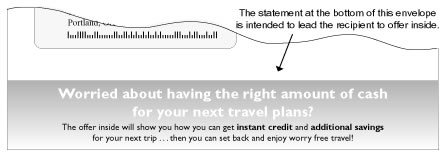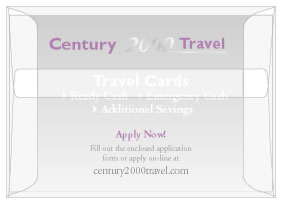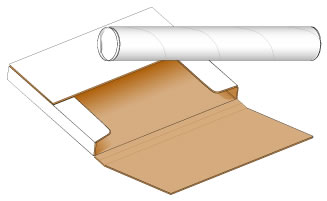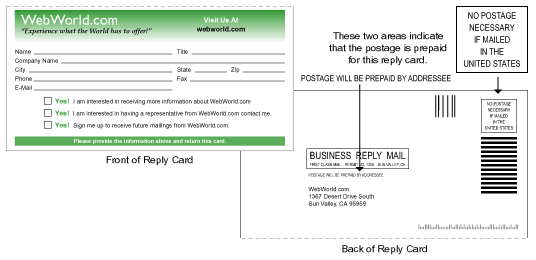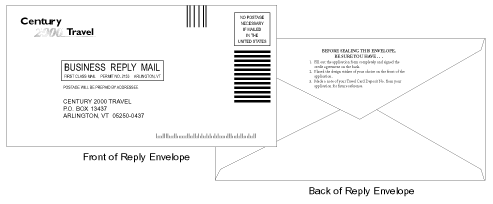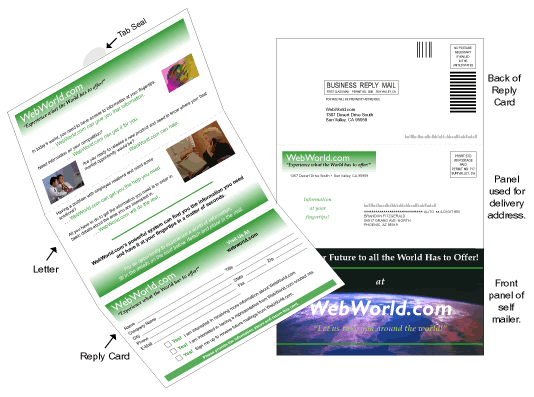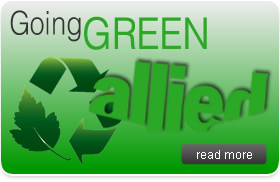Direct Mail Tutorial
There are many elements that can be used in a direct mail package and has its own purpose. It is important that all are used with the same objective in mind which is to peak the interest of the recipient and for them to explore the mailer and finally to accept the offer. Elements used in a direct mail package may vary according the promotion but there are some basic specifications that need to be determined. .
Basic Specifications:
|
Optional Specifications:
|
Some of the basic elements for direct mail are the outer envelope, sales letter, brochure, response device, inserts and reply envelope. The basic elements are explained below.
Mailing Envelope
The design of the outer envelope is important and can make the difference in whether or not the recipient opens the envelope to see the content/offer. The mailing envelope should be constructed to offer an idea of subject enclosed.
Curiosity Creating curiosity is a great attribute to a mailer and can be accomplished by using an incomplete sentence or story to lead them to the inside of the envelope. A headline can be put on the outside of the envelope as well. There are lots of options that a good marketing firm can assist with.
Targeting Design the envelope according to the target and produce the materials targeting that group as the response rate will be greater if the recipient feels the mailing is being sent to their particular industry sector. Also personalizing the message to the interests of the people in the mailing. Attention Getter A window, other than an address window, can be placed on an envelope to allow the recipient to view part of the content and can generate curiosity to increase the response of that mailing. Having something like device, such as coins, stamps, discount cards, membership cards or sample products, show through the window will increase response. Transparent envelopes are also good and work like a window in seeing the envelope content. A transparent envelope allows you to view all of the content on the front and back side of the package. The information you do not want viewed before the envelope is opened can be collated between the top and bottom pieces of the package.
The transparent envelope makes it easy to view the important information, items that imply value and enclosed selling devices. Transparent envelopes also come in colors to add another creative design feature to your package. Value Using value or making the envelope look well made and important is a an additional way of getting the recipients attention and a high response rate.
Urgency Conveying the feeling of urgency makes people feel as they do not respond, they will be missing out on an opportunity. Expiration dates, limited quantity available, are tow examples of ways to express the urgency of an offer. Envelope Size There are many standard size envelopes and these are available in different styles and colors. The most commonly used size in direct mail is a 6" x 9" booklet and is a size that works for many mailings. It is the largest size that some inserters will take. Using a standard size envelope is generally the most cost effective option but if the mailing is large enough and have the time for a special special order than a custom envelope can be almost as cost effective and worth the increase in response that it may create. When choosing an envelope that is custom made, be sure to consider postal regulations so that the envelope complies with the minimum and maximum requirements. Failure to comply to the postal requirements can increase your postage costs dramatically. Also, if you want to use automated rates, there are other guidelines that must be followed. Automated rates are approximately half of regular First Class Mail rates. To see details on the postal requirements, see Postal Regulations - Outgoing Mail. |
|
Mailing Package Alternatives There are alternatives to using an envelope like a box, tube or polybag. Expect costs to increase over envelopes |
|
The Letter
The letter of your mail piece is used to tell your story and convey the message. It can be as short or long as necessary. You will need to decide on the type of structure you will want the heading and signature of your letter to be. The structure type could be corporate, personal or product reference.
| Certain sizes have a tendency to imply that the letter is a certain type.
Using a non-standard size may add more interest than a standard size. An 11" x 17" can be folded to an 8 1/2" x 11", giving four pages to present your message. Your letter can be most any size that fits with the overall concept of your promotion. One thing to keep in mind is how well it will cut out of a standard stock size, eliminating as much waste as possible. The cut out is something that should be checked with the production department. The letter should be easy to read and have a good look to it. Using personalization, headlines, bold type, handwritten notes and drawings or photos will help stimulate interest. Use short easy to read paragraphs. If it is a business letter, it should be more formal and printed only on one side. |
|
A brochure does not always have to be included as part of the direct mail package. If the brochure does not provide essential information or purpose to the overall message of the promotion, it is an unnecessary cost. If a brochure is designed well and adds credibility to the message, it is well worth including. Testing with and without the brochure will help to evaluate its value.
The brochure is a good way of showing more details about a product or service. The recipient can actually see a picture of the product being offered or a setting in which a service is being rendered. It helps to give them a better perspective and feel for what is actually being offered.
The brochure should contain all of the major aspects of the offer that are contained in the letter, such as the basic offer, testimonials, warranties, contact information and order information. The brochure could also be designed to contain the response piece as one of the panels. A perforation would be added so that it could be removed and mailed back. The perforated response section would eliminate the need for a separate response piece.
The recipient should be able to understand the entire promotion by just reading the brochure. At times, it may be the only thing that is read by the recipient. The brochure, like all the elements of the direct mail package, should stimulate the recipient to respond to the offer.
|
Brochure Formats
Brochure - Generally thought of as a 4 or 6 page, printed and folded piece. Booklet - Eight or more pages glued or stapled together. Broadside - Larger than a brochure and is intended to be unfolded to a flat piece. It usually consists of both parallel and perpendicular folds. Pamphlets, Flyers, Inserts & Stuffers - Smaller items that generally unfold to be no larger that the letter is when unfolded. |
The main purpose of all the elements in the direct mail package is to get someone to respond with the response piece. The response piece may be anything from a complex credit application to a single "Send more information" card.
|
The reply envelope is an important part in the direct mail package. It encourages a faster response and makes it convenient for the recipient to respond.
The reply envelope can be designed creatively to reflect the theme of the promotion. When designing the envelope, there are some restrictions that have been set up by the United States Postal Service as to where copy can be place on the envelope. Following the guidelines will still give you some good options for creatively placing copy. The envelope can have postage prepaid or request that a stamp be added. For details on the USPS guidelines for business reply mail, see Postal Regulations - Business Reply Mail. The back of the reply envelope can also be printed. It is a good place to remind the recipient of the necessary steps that must be followed when filling out the respond card.
|
Generally the letter, brochure, reply device and mailing envelope are all that you need in your direct mail package. Some of the reasons that additional inserts are used would be to draw more attention to something that may get lost in the main message, or it can be used to offer a special deal in addition to the main offer.
Inserts of this type are sometimes called buckslips. It could be an additional letter from another person of authority within the company, such as the president, reinforcing what a valuable offer it is. The letter could also be a testimonial from a satisfied customer on the quality of the product or service.
Different variations of inserts may be used as a way to use versioning in the direct mail offer.
Elements of Self Mailers
The self mailer format has gained popularity in the last few years. It is different from the traditional direct mail format of a mailing envelope, letter, insert and reply piece in that it is designed with all the different elements combined into one. All elements are printed in one press run, making it less expensive than running them all as separate runs, especially in larger quantity runs.
The self mailer forms its own outgoing envelope and can have a business reply envelope included as part of the mailer. There are many formats available with unlimited possibilities.
|
Information Request
When the offer consists of a request for information, you are really dealing with a two step process. The original offer is to send back a reply that requests additional information. The second step is supplying the information requested. The requested information can be in the form of a brochure, information kit, video tapes, CDs or DVD discs.
The second step should have the same creative design and tactics as the original offer. It should contain a letter which clearly states the actual offer and is designed to get the attention of the recipient. The mailing package and any additional inserts must be interesting and designed to persuade the recipient to take the necessary action to read, view or access the information provided.
FOR MORE INFORMATION PLEASE SEE THE FOLLOWING LINKS:

